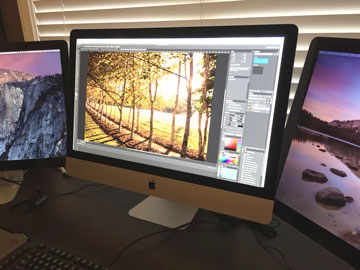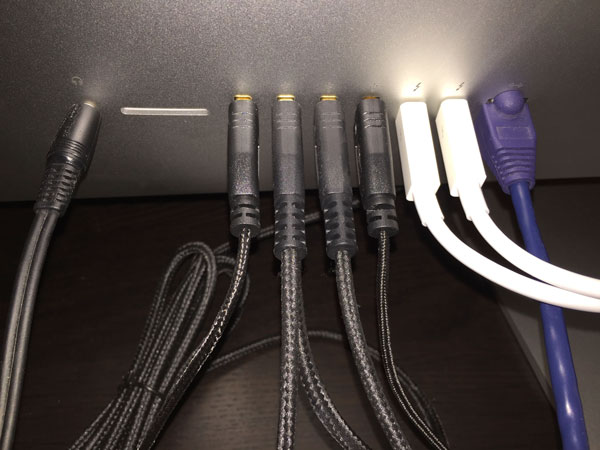Review: Apple iMac with Retina 5K Display
December 20, 2014 — by Per Christensson
 About two months ago, I published an article about Apple's new iMac with a 5K display, alluding to the possibility that I might get one. Well, I did. There were two reasons why I made the decision: 1) A Mac specialist at my local Apple Store demonstrated the 5K iMac could handle two external Thunderbolt displays, and 2) I've learned from past experience to NEVER wait for Apple to release a new Mac Pro.
About two months ago, I published an article about Apple's new iMac with a 5K display, alluding to the possibility that I might get one. Well, I did. There were two reasons why I made the decision: 1) A Mac specialist at my local Apple Store demonstrated the 5K iMac could handle two external Thunderbolt displays, and 2) I've learned from past experience to NEVER wait for Apple to release a new Mac Pro.
While I would have preferred a Mac Pro, the new iMac is pretty sweet. I upgraded every single component possible, which means my new iMac has a 4.0 GHz i7 processor, 32 GB of RAM, a 1 TB SSD, and an AMD Radeon M295X GPU with 4 GB of memory. I would have preferred 64 GB of RAM and more video memory, but overall, I'm pretty happy with the specs.
The 5K Retina Display
Of course, the most notable spec of the new iMac is the display. It supports full 5K resolution (5120 x 2880), which totals 14,745,600 pixels. If you add my two Thunderbolt displays (2560 x 1440 each), I have 22,118,400 pixels between the three displays. That means the GPU is rendering 22 megapixels in real-time, or 60 times per second, assuming a 60 Hz refresh rate. 22,118,400 pixels x 60 Hz = 1,327,104,000 pixels per second. That means my new iMac is processing over 1.3 billion pixels every second.
While that math is impressive, what's more important is how the 5K looks. Some visitors might remember that when I began using the iPhone 4 with a retina display, my computer monitor started looking blurry. I knew that one day high-res displays would make it to desktop computers, and that day has finally come. The iMac's 5K display is awesome. The text is crystal clear and the photo detail is incredible. The colors are especially vibrant on this new iMac and maximum brightness level is higher than what I need.
My only complaint with the iMac's 5K display is that the black levels are pretty bad. The lowest black level is quite a bit brighter than the blacks on my two Thunderbolt displays. It's easy to compare, since the 5K display is nestled in between them. The good news is that dragging windows between the three displays is seamless. The window contents convert from hi-res to regular resolution as soon as I drag them to the Thunderbolt screen and vice versa. It's really helpful to have the Thunderbolt displays so I can view images and websites the way mere mortals see them on their standard HD displays. Perhaps the biggest drawback of the retina display is that regular resolution images are upscaled, making them appear ironically less sharp than they do on a standard display. I've gotten used to it, but it's still important to have my secondary displays available for web development.
Performance
The display is great, but how does the 5K iMac perform? So far, I've been pretty pleased with the application performance and common tasks such as starting up and copying files. The 4.0 GHz CPU and flash storage give this machine a noticeable performance boost over my previous 2011 iMac. Applications open almost instantly and scrolling through webpages is completely smooth. Photoshop renders images on the new iMac in about half the time as my old machine.
My biggest complaint with the 5K iMac is that StarCraft 2 performs horribly. Even when I run the game in half resolution (2560 x 1440) with medium settings, the gameplay is choppy. The frame rate drops well below an acceptable 30 frames per second when there is a lot happening on the screen. Additionally, there is a bug where the cursor is not confined to the primary display on the right side, so I have to disconnect my right Thunderbolt monitor just to play the game. Even when only my iMac screen is active, the internal fan runs at a high speed and is noticeably loud. I'm hoping these issues are software-related and either Blizzard or Apple can improve the drivers for the Radeon M295X.
Hardware
The 5K iMac's ports are not as plentiful as the Mac Pro's, but there is still a decent selection. There is an audio in/out jack, an SD card slot, four USB 3.0 ports, an Ethernet port, and best of all, two Thunderbolt 2.0 ports. Of course, I use every single one.

Apple's last few iMacs, which don't include optical drives, have a sleek design where the sides are less than a centimeter in width. I really don't understand the point of this, since the side profile of an iMac is not that important. Additionally, it seems that widening the chassis would allow for more airflow so the fan wouldn't have to run as much. While the iMac is super-quiet (especially with flash storage), the fan runs far more frequently on this machine than than any other iMac I've owned. I wish Apple would just put the computer in the base instead of right behind the screen, which generates a fair amount of heat on its own. Even if the base was four times the size of a Mac mini, I think the computer would look sleeker than the current iMac models.
Pros
- Incredible high-resolution display
- Works with two external Thunderbolt displays
- Ultra-fast performance in most applications
Cons
- Poor gaming performance
- Frequent fan noise
- Standard resolution images are somewhat blurry
Summary
While I don't love the form factor of the 5K iMac, I do love the screen. So far the performance has exceeded my expectations in everything besides gaming. If you're planning on getting a new iMac and you can swing an extra $800 for the 5K display, I'd say it's well worth it. Just make sure to upgrade the processor and graphics chip as well. You'll be glad you did.
 Home
Home November 12th
November 12th